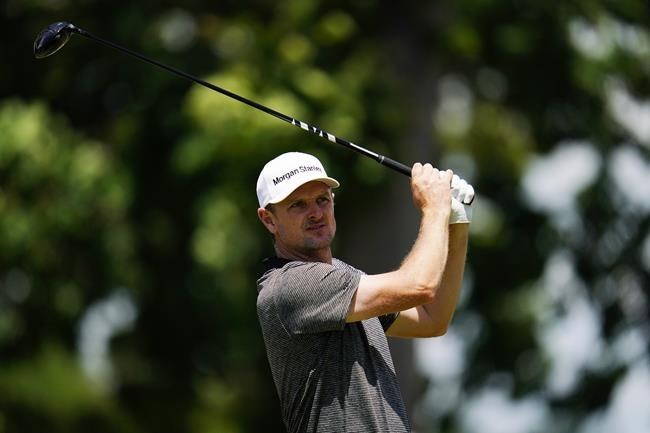BROOKLINE, Mass. (AP) — The U.S. Open isn't the only American major that has felt like an afterthought, lost among chatter and innuendo about topics unrelated to birdies and bogeys.
Golf was no longer the primary concern going into the 1990 PGA Championship at Shoal Creek in Alabama. The club founder had said Shoal Creek would not be pressured into accepting a Black member. Corporate sponsors began to withdraw TV advertising, protests were planned and Shoal Creek extended membership to a Black insurance executive a week before the PGA.
Until the first tee shot, most of the stories were on the controversy and its ripple effect in golf, not whether Nick Faldo could win his third major of the year.
Battle lines were drawn at the 2003 Masters between activist Martha Burk and her demands that Augusta National have a female member, and club chairman Hootie Johnson who stubbornly said that day may come, but “not at the point of a bayonet.”
Tiger Woods was going for an unprecedented third straight Masters, and he got 10 questions from the media about social issues and the chaos at Augusta. And then when Thursday arrived, rain washed out the opening round.
The difference is the U.S. Open has been overshadowed by a development not of its own doing.
Just its luck, a return to The Country Club for the 122nd Open and its century-old heritage came one week after the Saudi-funded LIV Golf rebel series began outside London.
Phil Mickelson and Dustin Johnson, the two biggest defectors, are among 14 players suspended by the PGA Tour for signing up and who are now playing the U.S. Open. Rumors have rampant all week that more players could be signing up for the Saudi money next week.
Mickelson defended his decision. Rory McIlroy said players who signed up for the 54-hole events with no cut and guaranteed money are “taking the easy way out.”
Golf, anyone?
“We're praying that changes tomorrow,” USGA chief Mike Whan said Wednesday. “Even I can say that you don't have to ask how we feel about it. Ask 156 players that are grinding it out to get to tomorrow. They're trying to focus on the same thing we're trying to focus on.
“I think — hopefully — as soon as we tee this up tomorrow, we'll have something else to talk about, at least for the next four days.”
It starts with a local flavor. Michael Thorbjornsen of Stanford, who grew up in the Boston area and won a U.S. Junior Amateur, hits the opening tee shot from No. 1. Fran Quinn, who is 57 and lives about 40 minutes away from Brookline, will start on No. 10.
Mickelson has received only cheers and support — not quite as raucous as in other years — during his practice rounds. He can expect a few renditions of “Happy Birthday” during his opening round because he turns 52 on Thursday.
What they face is an old-styled course, dense rough around most of the tiny greens, fescue framing fairways that are not the narrowest for a U.S. Open and still an important part of keeping big numbers off the card.
The par-3 11th hole is 131 yards by the card and likely will play under 100 yards at some point. The fifth hole is short enough that players can drive the green.
The U.S. Open typically is about precision over power, with patience key for anyone. Recent history, however, leans toward big hitters — Jon Rahm last year, Bryson DeChambeau at Winged Foot, Gary Woodland at Pebble Beach, Brooks Koepka back-to-back and Johnson at Oakmont.
“You should probably have an advantage if you're a little bit longer,” said John Bodenhamer, the USGA's chief championships officer who sets up the course. “How it plays here, I don't know. We're going to find out. It's been 34 years since we've been here.”
That was in 1988, when Curtis Strange beat Nick Faldo in a playoff. Both were known for precision iron play and avoiding big mistakes.
“This will be a good old-fashioned U.S. Open with rough, and we’ll see how they navigate that and what they use off the tee,” Bodehamer said. “I am telling you, with these small greens and the firmness, they’re going to need to be in the fairway.”
As for the prize money, the U.S. Open has fallen in line with other majors, if not a step up. The PGA Tour set the tone by jacking up the purse of The Players Championship to $20 million with hopes the majors might tag along.
The Masters and PGA Championship bumped their purses to $15 million (both at least a $3 million increase), while the U.S. Open has gone up $5 million to $17.5 million.
That doesn't compare with the $25 million in prize money the LIV Golf series is offering for its 54-hole events that last week only had four of the top 50 players in the world.
This is about history, a trophy that dates to 1895, making it the second-oldest championship in golf. That should be enough to get anyone's attention over four days.
“We're here at major championship, and we’re here to win the U.S. Open, and we’re here to play and beat everyone else in this field, in this great field,” two-time major champion Collin Morikawa said. “That’s what it’s about.”
___
More AP golf: https://apnews.com/hub/golf and https://twitter.com/AP_Sports
Doug Ferguson, The Associated Press




